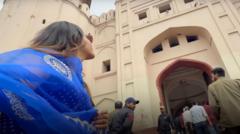**The SpaDeX mission's successful docking opens the door to India's aspirations for an indigenous space station and lunar exploration.**
**India's SpaDeX Mission Marks a Milestone in Space Docking Technology**

**India's SpaDeX Mission Marks a Milestone in Space Docking Technology**
**ISRO achieves significant breakthrough in inter-spacecraft cooperation for future exploration.**
India's space agency, ISRO, has successfully accomplished its first space-docking test through the SpaDeX mission, marking a historic milestone for the nation's future in space exploration. Launched from Sriharikota on December 30, the mission involved two small spacecraft—dubbed Chaser and Target—performing a docking maneuver, a fundamental technology needed for India's aspirations to create an autonomous space station and facilitate lunar missions.
Scheduled initially for January 7 but postponed due to technical adjustments, the docking was finally executed with precision. Prime Minister Narendra Modi and Federal Science Minister Jitendra Singh praised the achievement, acknowledging it as a crucial step towards realizing India's ambitious space projects. Each spacecraft weighs approximately 220kg and was designed to reconnect after achieving a carefully planned separation distance to allow controlled docking.
Mila Mitra, an expert from a Delhi-based space education company, explained that once separated and moving at different speeds, the spacecraft successively reduced their distance from 15 meters to just 3 meters before successfully docking. A critical aspect of the operation was ensuring that both spacecraft maintained identical orbital positions to facilitate the docking procedure.
In successive experiments, ISRO scientists plan to demonstrate power transfer between the Chaser and Target, signaling the potential for future in-space servicing missions. Throughout this process, inter-satellite communication will play a vital role, providing real-time data exchange necessary for coordinating the positioning of both vessels.
The SpaDeX mission has also deployed various scientific instruments to further investigate radiation exposure in space and monitor Earth's natural resources—proving ISRO's commitment to efficient exploration practices. Utilizing components of the launch rocket for subsequent experiments, ISRO aims to minimize space debris while maximizing the scientific output of its missions.
In a significant development, experiments aboard the spacecraft have demonstrated the viability of growing plants in micro-gravity, indicating potential food sustainability for astronauts on extended extraterrestrial journeys. The robotic arm sent with the mission aims to manage space debris, and its functionality will be pivotal when building future space habitats or during India's upcoming lunar missions.
As ISRO continues to expand its repertoire of space technologies, the success of SpaDeX symbolizes a promising trajectory for India's leadership in space exploration while laying the groundwork for greater interstellar adventures.
Scheduled initially for January 7 but postponed due to technical adjustments, the docking was finally executed with precision. Prime Minister Narendra Modi and Federal Science Minister Jitendra Singh praised the achievement, acknowledging it as a crucial step towards realizing India's ambitious space projects. Each spacecraft weighs approximately 220kg and was designed to reconnect after achieving a carefully planned separation distance to allow controlled docking.
Mila Mitra, an expert from a Delhi-based space education company, explained that once separated and moving at different speeds, the spacecraft successively reduced their distance from 15 meters to just 3 meters before successfully docking. A critical aspect of the operation was ensuring that both spacecraft maintained identical orbital positions to facilitate the docking procedure.
In successive experiments, ISRO scientists plan to demonstrate power transfer between the Chaser and Target, signaling the potential for future in-space servicing missions. Throughout this process, inter-satellite communication will play a vital role, providing real-time data exchange necessary for coordinating the positioning of both vessels.
The SpaDeX mission has also deployed various scientific instruments to further investigate radiation exposure in space and monitor Earth's natural resources—proving ISRO's commitment to efficient exploration practices. Utilizing components of the launch rocket for subsequent experiments, ISRO aims to minimize space debris while maximizing the scientific output of its missions.
In a significant development, experiments aboard the spacecraft have demonstrated the viability of growing plants in micro-gravity, indicating potential food sustainability for astronauts on extended extraterrestrial journeys. The robotic arm sent with the mission aims to manage space debris, and its functionality will be pivotal when building future space habitats or during India's upcoming lunar missions.
As ISRO continues to expand its repertoire of space technologies, the success of SpaDeX symbolizes a promising trajectory for India's leadership in space exploration while laying the groundwork for greater interstellar adventures.



















